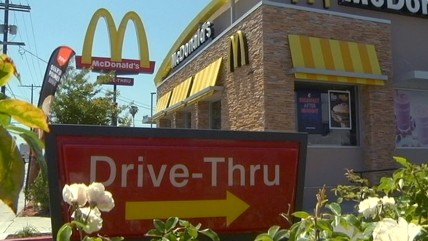| By Katie Little, CNBC
More complex menus are blamed as the average speed at seven chains increased to over three minutes -- eight seconds longer than a year ago.
Fast food just got a little less speedy due to more complex menus, according to a drive-thru performance study released Monday.
The average speed at the seven chains reviewed -- national leaders Burger King (BKW), Chick-fil-A, McDonald's (MCD), Yum Brands' Taco Bell (YUM), Wendy's (WEN), and smaller regional chains Krystal and Taco John's -- rose to just more than three minutes, which amounts to eight seconds longer than a year ago, according to QSR magazine and Insula Research.
In this year's ranking, Wendy's held on to its claim as the speediest chain, while Krystal customers twiddled their thumbs in the drive-thru line for an industry-worst average of 217.89 seconds each. Chick-Fil-A was second worst, with average wait times of 203.88 seconds. McDonald's posted its slowest showing in the history of the 15-year-old study, while rival chain Burger King was the only company to speed things up.
"Driving this increase in speed of service time is these more complex menu items," said Sam Oches, the editor of QSR, which covers quick-service and fast-casual restaurants. "Consumers are demanding more fresh, upscale menu items from fast-food restaurants and as these chains are answering that demand, the new menu items take a little more time to assemble."
Added complexity from items such as McDonald's Premium McWrap or Taco Bell's Cantina Bell menu means new operational procedures and additional ingredients, which translate to a more complicated assembly line.
Compounding this problem is a busier drive-thru line. The average number of vehicles in line rose 9 percent this year to 2.82 cars. Chick-fil-A had the longest average line at about six cars while the Taco John's line was about a fifth of that.
The annual survey armed researchers with stopwatches and clipboards and sent them through drive-thrus at the nation's top quick-service restaurants. The researchers then visited hundreds of restaurant units to gather data on more than 1,800 service times during the lunch and dinner rush hours while ordering a main item, side and beverage.
This was before the rise of the fast-casual restaurant, where growth has outpaced the overall restaurant industry's.
Still, accuracy has shot up from its early 2000s and late 1990s performance. Back then, only about 60 percent of some chains' orders were filled accurately. This year's average was about 87 percent, with Chick-fil-A leading the pack and Krystal being the least accurate.
So what do these longer wait times really mean for company bottom lines?
"It's hard to say," Oches said. "One theory is the slower the drive-thru, the fewer the cars that can get through and the less business you do, but I don't buy into that theory."
Still, it could be detrimental if regular customers get fed up with the slower wait times, he added.
"The experience is what's important and going into that is accuracy and customer service, because if the drive is slower by 20 to 30 seconds, customers will forgive you as long as they get a good experience," he said.







0 коммент.:
Post a Comment